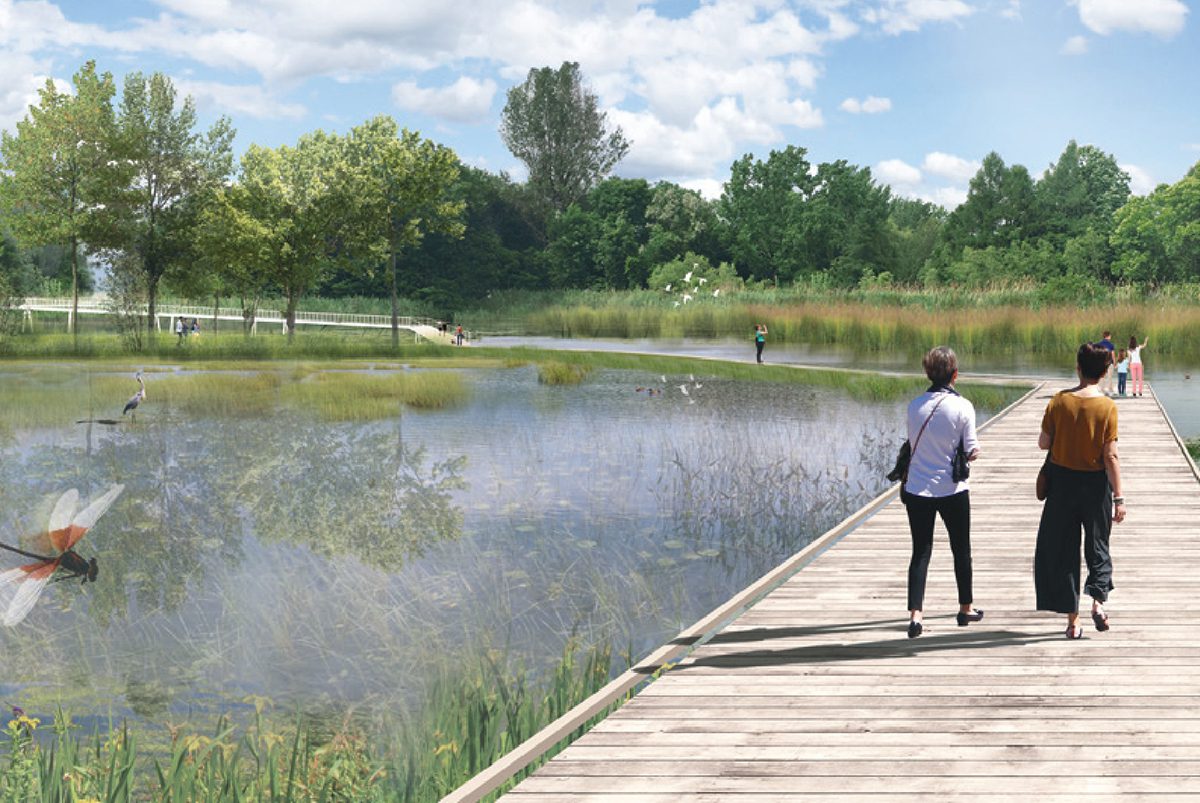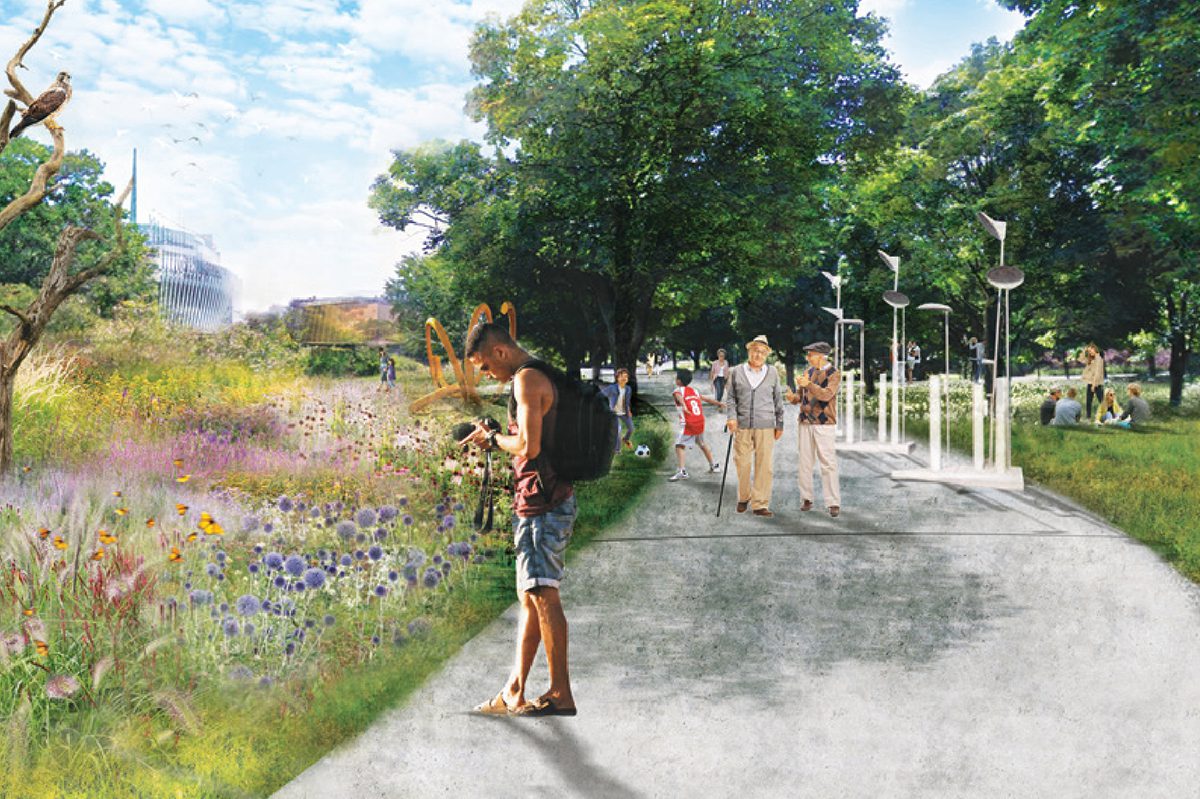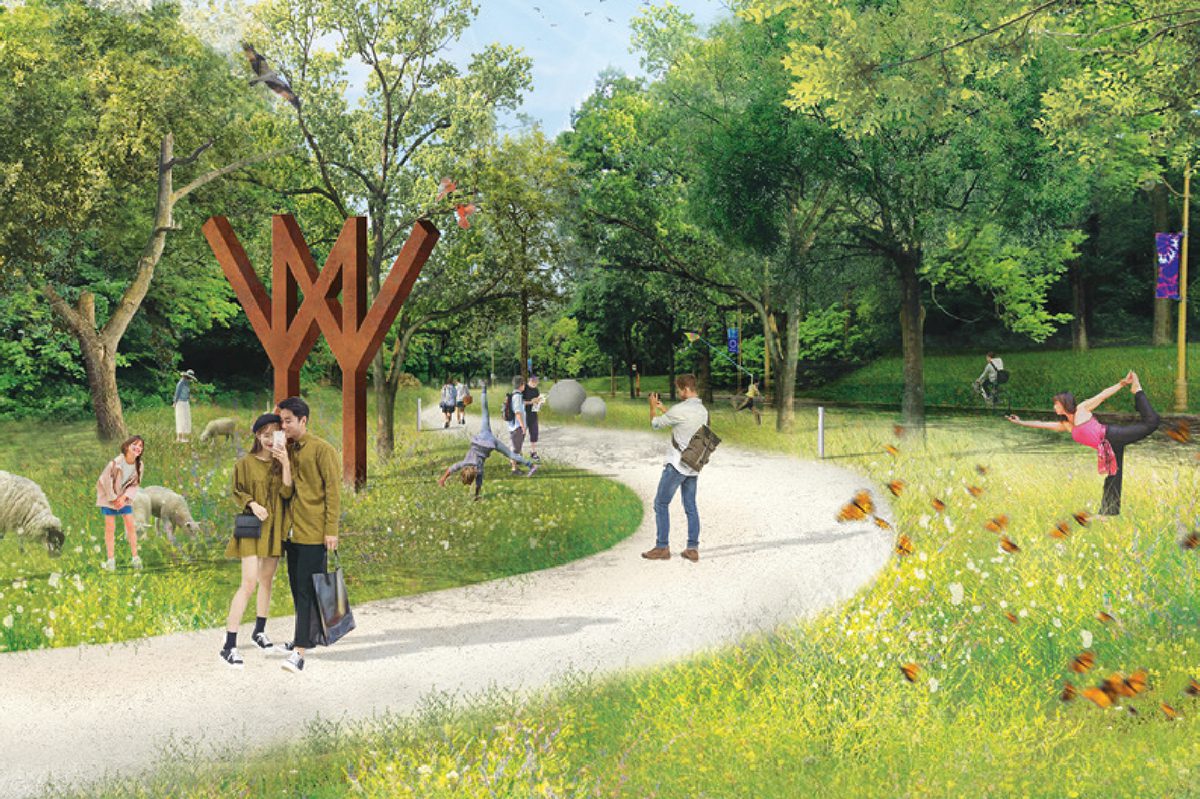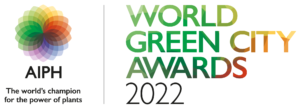Addressing the urban challenge
Breadth of the issue – How are the problem(s) that are being tackled by your initiative affecting citizens/local businesses or a significant component of the local wildlife?
Due to a lack of a plan to guide development, Parc Jean-Drapeau has long suffered from a paradox of chronic neglect and intense, one-off modifications that failed to respect its essence as an insular urban public park. Over previous decades, the natural areas and heritage buildings degraded, and the park became more fragmented as private uses took hold of public spaces.
The Parc Jean-Drapeau Master Plan 2020-2030 is the result of a massive public outcry against a plan to develop a large open-air amphitheatre on Saint Helen’s Island in 2017. This major project, implemented without any public consultation process, included the removal of approximately 1,000 mature trees in the heart of the park and the destruction of an ecological water feature. The result, an expansive, mineralized surface that can accommodate up to 65,000 spectators, opened in November 2019.
The development of the Espace 67 amphitheatre in 2018 galvanized one of the most extensive public consultation processes in Montreal’s history and raised awareness of the park’s current state: the degraded condition of its green spaces due to a combination of overuse and neglect, the disconnection between residents and the park as a public place, and the lack of a shared vision or identity for the park. The Parc Jean-Drapeau Master Plan responds directly to the recommendations from this public consultation process and commits to regenerate, reconnect, and reinvent the park in a way that puts people and nature (and their relationship) at the centre of all its discussions and actions.
Depth of the issue – How seriously are the problems being tackled by your initiative impacting the life of the citizens/businesses/wildlife concerned?
The Master Plan is much more than a vision for future park development. It embodies a commitment to transform decision-making processes and to update the practices and operations of the organization in a way that is both people- and nature-centred. The strategic framework of the Master Plan – comprised of guiding principles, design principles, development axes, and strategic orientations – provides a comprehensive structure upon which all processes and actions are based. The six strategic orientations are designed to function in a transversal manner throughout the SPJD and serve as an anchor for decision-making. Sustainable development is a central hub to the other orientations: innovation, citizen experience, conservation, open governance, and reconciliation.
The SPJD has put the strategic framework into practice through many recent initiatives, including establishing a partnership with a non-profit organization, the Ecological Transition Campus, to serve as a citizen engagement hub and research lab and the creation of an Indigenous Advisory Committee mandated to ensure that the SPJD honours its commitment to reconciliation. The advisory committee is currently developing Indigenous design guidelines to inform the design-thinking and implementation for future projects.
As a result of the Master Plan and the lessons learned from the Espace 67 project, the SPJD is committed to working in partnership with many stakeholders, including residents, community organizations and Indigenous communities, to ensure that the redevelopment of the park honours the Indigenous presence and respects sustainable development practices while reflecting the needs and desires of the many histories and communities that constitute Montreal.
The power of plants and natural ecosystems to deliver benefits
How is the initiative shaped by scientific evidence of the potential for plants and natural ecosystems to deliver benefits?
The literature on large urban parks in the western world, Park People’s Canadian City Parks Reports, studies by the INSPQ (Québec’s public health institute) and numerous books on landscape architecture, biology, sustainable development, and ecological transition informed the design process. Knowing that urban parks can be 10 to 15 degrees cooler than residential and industrial areas, the equivalent of more than 30 soccer fields will be given back to the citizens, fostering new experiences in nature. The master plan ensures that the park will reduce its heat islands, offering a variety of open, semi-shade and full-shade treed spaces that provide a cooling effect. There is a significant correlation between the percentage of shade cover in the parks and the number of people seeking reprieve from the sun, whether for its cooling nature or for UV protection. An analysis of the ecological value of the existing plant habitats (structures, forms, areas) preceded the master plan. Habitats with multi-stratum vegetation, characterized by their high biomass and plant diversity, were considered to be of greater interest than habitats with simpler, less dense, and less diverse structures. The vegetation strategy adopted in the design is based on this analysis, plus the recommendations of the study by Francoeur, Dupras et al. which states to establish a biodiversity corridor and to improve ecological complexity one must increase the number of plant habitats of great ecological interest, manage and diversify plant habitats and introduce new types of habitats, such as shrublands, prairies, and three-layered stratified forests.
How has the city exploited the potential of plants and associated ecosystems to deliver more than one benefit?
Increasing the complexity of low vegetation zones will help support pollinator species in serious decline and increase ecosystem services. Together, this will help increase the resilience of Montréal’s natural urban heritage. As we seek to adapt to climate change and augment biodiversity, it is important, as the Friends of the Parks’ report reminds us, to ensure that parks include natural areas. The Master Plan responds to this call to increase nature in urban areas and develop green infrastructure with its proposition to create an ecological corridor that traverses the park. This ecological connectivity will improve ecosystem performance, reduce the heat island effect, and provide a pathway for the park’s fauna. It is fundamental to the maintenance of populations of living organisms, their movement across the landscape, and to ensuring their genetic diversity at all scales.
The Plan provides guidance on transitioning toward eco-responsible practices that promote the establishment of native plants, encouraging biodiversity, pollinators, and cooling oases. Ornamental plantations, parking lots, and lawns are priority areas for this type of intervention. A significant portion of the green spaces will transition toward a sustainable management system, which will improve the contribution of green infrastructure in the park. In addition to the existing filtering marshes, wetlands will be restored and constructed, providing many additional ecosystem services. Not only will Parc Jean-Drapeau have more ecological green spaces that contribute to Montrealers’ public health, but the increased biodiversity of the urban green space will have a restorative effect and enhance a sense of well-being.
Innovative and Collaborative Solution
How does the initiative show evidence of feasibility, including on-going financial and logistical support?
The planning includes a funding target for the Plan of nearly $970 million. $490 million, 50% of the total, is financed by the City of Montréal through an annual budget of $49 million in its 10-year capital investment plan. This sum is dedicated to the projects proposed in the Plan, this budget is divided between new development projects and the maintenance and renovation of existing park facilities. The City’s contribution includes amounts it allocates to the SPJD as part of the three-year investment plan, which represents almost half the annual budget allocated to restore existing buildings and infrastructure. The remaining $480 million will be covered through public and private partnerships.
Given the radical transformation of its mission and the massive infrastructure investments planned, the SPJD has developed a sequencing and financing plan to minimize the time required to implement the Plan and match the investments required with the sequencing of the realization of the various projects.
The Plan’s feasibility requires a transitional period to allow the SPJD to initiate its organizational transformation and acquire the skills necessary to begin the first projects. Spreading expenditures over time also helps ensure the availability of required human and financial resources.
Project planning was carried out using the cascade principle to take into account the many dependencies that exist between completion of certain projects and the start of others. This approach also assumes that refinement of the planning for each project will provide regular opportunities to update the overall sequencing of the Plan.
In what ways is the initiative innovative?
With this Master Plan, Parc Jean-Drapeau is making a clear socio-ecological shift. While greatly enhancing the diversity, quality, and quantity of its open spaces for visitors, the Plan sets bold targets: to increase the tree canopy by 30% and wetland areas by 40% and to decrease high-maintenance horticultural zones by 50%. The creation of an ecological corridor between two biodiversity hotspots where fauna and flora are particularly abundant – the Mont Boullé hackberry stand on Saint Helen’s Island and the riparian zones of Notre-Dame Island – illustrates a commitment to restore the ecological connectivity within the park. The Master Plan aims to improve ecological complexity by integrating the concepts of landscape performance and ecosystem services into the design and management plan, which will also incorporate traditional indigenous knowledge. The majority of lawn areas (which primarily align the roadways) will evolve into more diversified natural landscapes as the three-stratum forest expands. Sustainable management practices being introduced allow for the expansion of unmanicured herbaceous lands. Among the new types of plant habitats in the park, shrublands will provide new littoral environments near the river, which will differentiate the renewed contact with the water from inland landscape experiences. The uniqueness of these spaces will be reinforced by the development of new wetlands and the use of phytotechnology’s. In addition to the development and management of its lands, the park aims to achieve 85% of materials recycled, carbon-neutrality of activities and 100% eco-responsible programming while introducing urban agriculture on the roofs of several buildings.
How is the initiative supported by collaborative working across disciplines and sectors?
The Master Plan was produced by a multidisciplinary team of experts in strategic planning, design, sustainable development, and mobility and accompanied by an additional team of approximately twenty professionals comprised of architects, landscape architects, designers, biologists, and lighting designers. Since the plan’s adoption last April, the SPJD has developed partnerships with multiple stakeholders include a citizen-engagement eco-lab (the Ecological Transition Campus) and several multi-disciplinary advisory committees. The SPJD also in dialogue with community groups, local native plant specialists, key city departments (Public Works, Large Parks, Heritage, Ecological Transition, and Climate Resilience) and it has established research partnerships with university research chairs. An Indigenous advisory committee informs and guides the decision-making process, and an indigenous forest expert has joined the design teams to incorporate traditional knowledge into the planning, design and management phases of restoration projects. Exchanges with professionals across North America are ongoing in order to ensure excellence in park practices and operations. External round tables and ad hoc committees have also been established to ensure that the City’s plans, policies, and strategies are rigorously applied. All the expertise required to implement action plans and achieve targets has been integrated into our processes. The Master Plan process began with a large public consultation process, and it continues to build on this inclusive, collaborative, partnership-based approach.
How does the initiative demonstrate evidence of community support?
The development of the new Master Plan was a unique opportunity to undertake an ambitious, yet realistic, strategic approach in line with current trends in a changing society, especially in the face of climate change.
In April 2018, the extensive public consultation, conducted by the Office de consultation public de Montréal (OCPM), conducted a major citizen engagement exercise, and produced recommendations that highlight the population’s collective priorities for Parc Jean-Drapeau. In all, 192 opinions were presented, and 6,072 citizens participated in various OCPM activities on the future of Parc Jean-Drapeau. This was the second-largest consultation conducted by the OCPM to date.
The resulting 20 recommendations clearly demonstrate citizen investment to the park and a desire to make it an exceptional site through innovative practices in sustainable development and enhanced individual and collective experiences.
The involvement of several groups, including the park’s island partners (La Ronde, the Casino de Montréal, the Biosphere, the Stewart Museum), municipal departments and the Ville-Marie borough, as well as groups of experts and academics, also attests to the great mobilization of stakeholders, who were keen to make known their ambitions for Parc Jean Drapeau.
The SPJD has also initiated dialogue with the public, notably through the creation of an Indigenous Advisory Committee and a round table, as well as two citizen groups that participate in the deployment and implementation of the Master Plan projects.
Implementation, Impact and Replicability
How does the initiative demonstrate evidence of a track record of success against pursued objectives?
The development of the Master Plan allowed for the establishment of initial targets and indicators as well as a preliminary sequencing of projects. Since beginning the Plan’s implementation, this outcome has been used to establish a management dashboard that provides an initial impetus for the SPJD’s data collection and performance measurement efforts.
Throughout the Master Plan’s implementation period, the SPJD will ensure that the monitoring tools and targets are adapted to meet the expectations of Montréal society, consider realities beyond its control, and seize opportunities that will enable it to surpass the ambitions of the Master Plan. To ensure that the public interest is respected, this adjustment work must be done within the framework of open governance, which necessarily implies transparency of the process and consultation with stakeholders. In addition, SPJD will undertake a periodic review of the indicators to ensure their relevance. At that time, it will detail the objectives to be achieved over the following three years.
All the targeted performance indicators can be found in Chapter 8 (page 644) of the Parc Jean-Drapeau Master Plan 2020-2030.
How has the initiative had a ripple effect beyond the scope of the initiative itself, thereby demonstrating a change in the city’s and/or its partners’ way of working with plants?
Protecting biodiversity and ecosystem health is a global challenge and urban parks have an important role to play. Parks enhance the resilience of cities and contribute to the ecological integrity of our environment by creating opportunities for people to connect with nature in urban areas and by maintaining certain ecosystem services. Due to climate change and the search for greater resilience, large parks are becoming important to public authorities. Park administrators are called upon to rethink the aesthetics, move away from a traditional horticultural approach and toward sustainable management practices that improve plant habitats.
The Master Plan strongly emphasizes protecting natural and man-made landscapes and adopts an adaptive ecological design approach through extensive planting and by restricting access to fragile natural areas. This is the first example of its kind where preservation of the park’s heritage is combined with a contemporary design and the implementation of a complex plant system. A variety of plant habitat types are being created or enhanced: a three-layered stratified forest, shrublands, wetlands, prairies, mixed lawn areas with isolated trees and ornamental gardens.
The Plan outlines a new land management vision centred on both heritage and green infrastructure as means to respond to climate change. The park’s management strategy for green and blue spaces, which promotes plant diversity, is influencing the practices of municipal departments that seeking to learn more about our vision, processes, and practices. In addition, by implementing sustainable land use guidelines, the island partners must also implement these more environmentally friendly practices.
How have other cities expressed interest in the initiative, or what potential does it have to interest other cities and be customised to their own circumstances?
The Master Plan, bold and ambitious in its vision and its outcome-driven proposals, has established itself as a model in Montréal and an example for others to follow. Representatives from SPJD have been invited to present the Master Plan at several conferences, notably the World Urban Parks Congress and The Nature of Cities Festival.
The SPJD also shares its initiatives through multiple discussion and exchange spaces bringing together, among others, municipalities, institutional organizations, and non-profit parks organisations. Issues such as responsible procurement, low-impact event organization, responsible waste management aiming at zero waste and carbon neutrality are addressed. The objective is not only to inform and promote our targets and practices in terms of sustainable development, but also to mobilize these institutional actors to work toward ecological and social transition.
The Master Plan was also developed in accordance with the 17 United Nations Sustainable Development Goals and the orientations and commitments of the City of Montréal (ex. C40 Cities commitments). In fact, the City’s Climate Action Plan, Nature and Sports Plan and Urban Agriculture Strategy were all launched following the adoption of the Parc Jean Drapeau Master Plan. The City of Montréal’s Ecological Transition and Resilience Bureau is particularly inspired by the Master Plan and has initiated a collaboration with our organization.
Sustainability and Resilience
What efforts have been made to reduce the carbon footprint of the initiative?
Reducing the carbon footprint is reflected in the Master Plan’s goal of carbon-neutral operations by 2030. To target upcoming actions and acquire a good base of initial knowledge, a GHG emissions status report was developed, in addition to a study that revealed the amount of carbon sequestered by all the trees in the park.
To achieve this goal of carbon neutrality, two approaches are being used: decrease emissions and increase sequestration. In the first, replacement of the vehicle and machinery fleet with electric alternatives has been initiated and GPS has been installed on all units in order to better understand the driving habits and raise awareness of eco-friendly driving among employees. Reducing emissions in Parc Jean-Drapeau also involves the use of renewable energy, a sustainable mobility plan that aims to remove automobile traffic from the park, and the objective of recovering more than 85% of materials by 2030. These reduction targets will be combined in an emissions reduction plan currently being developed.
With respect to carbon capture, the park’s new vision prioritizes a renaturalization of the land. The 30% increase in canopy by 2030, in addition to the 40% increase in stratified forest and wetland areas will ensure greater carbon capture by the ecosystems within the park. Sustainable management practices will promote a diversification of low vegetation, allowing for greater sequestration compared to monoculture lawns that are maintained by traditional mowing methods.
How have the anticipated impacts of climate change been considered?
Given the increasing temperatures and heat waves, there is a significant need for cooling oases for citizens, both for their physical and psychological well-being. The Master Plan aims to reduce heat island surfaces by 20% through a process of demineralization: transforming asphalted surfaces to green spaces. Another impact of climate change is the increase in episodes of intense rainfall, flooding and drought. To ensure better water runoff management, four wetlands will be restored, including the redevelopment of a floodplain. These zones will improve water management and restore ecosystem services, such as carbon and pollution sequestration, water filtration, and biodiversity protection. Water filtration and ecological water management are also enhanced with phytotechnology’s, particularly two existing filtering marshes, but also the installation of green roofs. These contribute to a process of integrating climate change adaptation and mitigation measures into all new infrastructure and development projects, including improved building energy efficiency, to which green roofs contribute.
To enhance the resilience of our developments and ecosystems, native plants and biodiversity will be prioritized and protected. Exotic horticultural plants are increasingly being replaced by native perennials which contribute to biodiversity and are well-adapted to local conditions. Controlling invasive plant species is also a priority, with some areas already treated. A management plan for invasive species will be developed soon. For the lawns, the SPJD is testing the application of more ecological seed mixes in order to improve the biodiversity and resilience of these areas while reducing the need for frequent mowing.
What processes does the initiative include for it to be considerate in its use of soils and other natural resources?
In recognition of the ecological importance of soils, any fertilizers, pesticides and herbicides that cannot be used in certified organic farming, which are already minimally used at the park, will be completely banned from use within the park. This practice will minimize any potential pollution to the water, soil, and living beings within the park. The already restricted use of herbicides for the control of nuisance plants, particularly poison ivy (Toxicodendron radicans), will also be completely banned and replaced by ecological methods that have minimal negative environmental impacts.
In an effort to respect ecological processes, leaf and grass composting practices are gradually being implemented, which also naturally enriches of the soils of landscaped areas. Leaves that are harvested still have a second life, as they are used to produce compost. Finally, trees felled for safety reasons or because of disease are transformed into chips that are used directly on site.
In order to respect the soil and the natural ecosystems, areas that hold events will be restricted to well-defined and mineralized zones. This delineation will ensure, among other things, limited soil compaction and reduce damage to the vegetation caused by large crowds. This commitment includes an awareness campaign targeting visitors and promoters, informing them of the seven principles of the Leave No Trace ethic, including responsible trail use to reduce human impacts in natural environments.
Monitoring, Maintenance, and Management
How has the initiative been designed and implemented so that long-term needs for management and maintenance are reduced and can be met?
The implementation of sustainable management practices will reduce the frequency of annual maintenance compared to traditional lawn areas due to a reduced mowing frequency, as well as their greater tolerance to drought and grubs. By 2030, 40% of lawns should be replaced by zones that support greater biodiversity, such as prairies. It is expected that the increased use of native perennials will reduce the need for horticultural maintenance as these plants are generally better adapted to the environmental conditions of the area.
The prioritization of ecological and sustainable methods outlined in the management plan for green and blue spaces will ensure that, over the long term, natural processes to take over with very little human intervention in these ecosystems. For example, the control of invasive plants, the ongoing monitoring of these efforts, and the use of bioengineering in the restoration of riverbanks will ensure a more natural evolution of the ecosystems in the park.
To prevent potential damage to landscape features and amenities, various guides are being developed for employees and stakeholders. These guides serve as tools to help in decision-making and environmental protection when intervening on a site within the park, thereby reducing maintenance requirements. These tools include a site utilisation guide for promotors and a trail and road use map that specifies which paths can handle certain vehicles and to ensure no one drives through the green spaces.
What protocols are in place to facilitate monitoring of results?
The completion of the Master Plan required a new performance-based management process that was specific and measurable enough to be able to monitor and report on.
In a progressive way, the park is currently:
- Establishing priority initiatives and action plans to be deployed, based on targeted objectives;
- Investing significantly to ensure profitable, sustainable, responsible development and efficient use of resources;
- Adopting a results-based management approach that will allow the gradual implementation of a management dashboard.
The SPJD has moved from a means-based management approach to a results-based approach. This evolution allows the SPJD to meet the targets defined in the Master Plan and ensures accountability for their achievement. The SPJD is committed to maintaining accountability and transparency in its governance by communicating all relevant information to the public interest.
The SPJD aims to achieve a high level of excellence in all its areas of activity. Performance management will allow for benchmarking, monitoring, evaluation, and reporting on project progress. This reform will enable the organization to measure and be evaluated on the delivery and quality of its services.
How has the initiative been enhanced in response to monitoring of results?
Learning and sharing knowledge are facilitated through several efforts, both internally, within the park, and externally, in exchange with other municipal entities and partners. The Master Plan lays the groundwork for many educational opportunities and exchanges of knowledge. For example, bio-indicator surveys and monitoring in the forested area will be part of research-action projects in collaboration with universities and the Ecological Transition Campus as well as in partnership with indigenous traditional knowledge experts to inform both park operations staff and the project design team to guide the redevelopment and restoration plans. Communication strategies include adding informational signs to explain our ecological practices and way to enhance and protect biodiversity in urban parks. In addition, parks grounds staff are engaged in a process of learning and adopting new ecological management practices, including methods to reduce pesticide and herbicide use, planting strategies that augment biodiversity and operations that encourage naturalisation in the park.

























